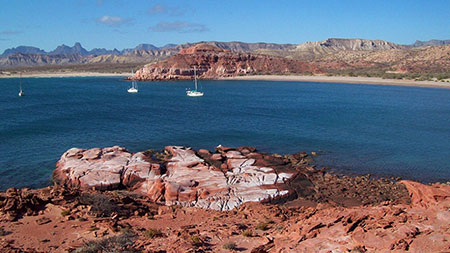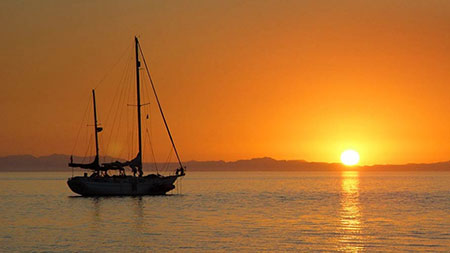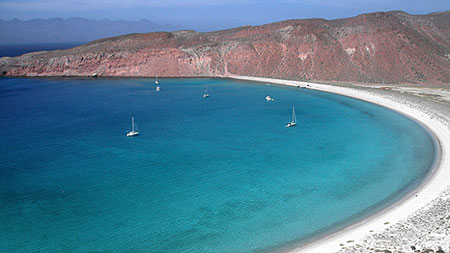Anchoring & Anchorages in the Sea of Cortez
Contributed by Tom Zyber, BajaInsider.com magazine
The Sea of Cortez is certainly my main attraction to living in Baja California Sur. And no time of year is better for recreation on the Sea than mid-October to late November. The summer heat breaks, the humidity drops dramatically and yet the waters of the Sea are still incredibly warm and inviting. Snorkeling and scuba diving in the Sea of Cortez peak during the same time period with visibility sometimes in excess of 20 meters. The days are still warm enough to inspire you to take a swim, while the nights cool off nicely so you can rest up for the day ahead.

When you live in a vacation destination like La Paz on the beautiful Sea of Cortez it seems rather silly to select a vacation destination somewhere else. As a warning to other looking to spend ‘just a few weeks’ in the Sea, well it just doesn’t work out that way. After 10 years of orbiting from our home port in La Paz there were still destinations within our one week time frame that we had yet to visit.
The average term of boat ownership is three years; I’ve enjoyed this sport for 45 years. (I started when my anchor weighed more than I did) We racked up some good cruising miles within the Sea this year, making several trips north from La Paz, each a little further into our unknown. In making our plans for our desired anchorages we looked to mix new anchorages with those secure anchorages we had known before.

The first week of November is still early in the cruising season and you can count on most of the anchorages having plenty of room. Crowded anchorages are a change I have witnessed over the last decade. “In Season” it is now rare to wake to being the only boat in an anchorage, even the more remote ones. You almost always are accompanied by the drone of a motor yachts generator through the night in the popular places. In season a chorus of Honda 2000’s joins in from the smaller craft.
With the increase in boat traffic it becomes more important for skippers to know their ground tackle (anchoring gear) and to anchor courteously. It is always the skipper’s purgative to put out as much chain or rode as he or she thinks necessary, providing he doesn’t swing into another boat. Chapman’s, the bible for seamanship, recommends an anchoring scope of 5:1 to 10:1 (in heavy weather) with rode, 3:1 to 5:1 for most anchoring conditions with all-chain. This presumes that you have the right sized gear for your boat.
Most anchorages in the Sea are sand, a few are rocky but those are easy to avoid in most cases. I like to lay out about a 5:1 all-chain; I wouldn’t sleep as sound with Chapman’s suggested 3:1. Remember your tides when laying out your anchor, in the southern Sea a dramatic lunar tide is about 1.5 meters, tide are more dramatic in the northern Sea. In many anchorages through much of the year the winds can shift 180° after sunset. When you have tension on the chain, set your anchor with a slow but firm reverse of the engines, not doing 4kt running yank in reverse and hitting the end of the chain with a loud "CLANK" as I saw a boat do in San Evaristo this trip. Eeeesh – rookies!
Most anchorages in the Sea are 6 to 8 meters deep with good holding. We were ‘advised’ on the radio in one calm anchorage of about 7 meters that the neighboring boat had out over 75 meters of chain on a 12 meter power boat. Even with the tide that is over a 10:1 anchoring ratio.
There are only three reasons to have out that much chain: 1) you are expecting hurricane force winds 2) you have no idea what you are doing and the capabilities of your gear or don’t have the correct gear 3) you’re just plain an inconsiderate “anchorage hog”. In years gone by I too have been known to anchor in the middle to scare off others who might want to join my secluded location. But those days are gone. With some safe anchorages hours apart, being an ‘anchorage hog’ could cost someone else dearly.

Finally in anchoring, know your swing radius. Most boaters have no idea how small the circle of swing really is. With a proper 5:1 scope in 7 meters of water you have 35 meters of chain out. Your swing radius is only about 28 meters. Roughly speaking, if it would take a good throw to toss a beer to your neighbor, you should be far enough apart. Boats of dissimilar anchoring (rode vs.: chain) or hull design (sail, multi hull or power) should take more care when anchoring close. When I sailed the Mediterranean the anchorages were so crowded we put out fenders at night. Those days haven’t made it to the Sea of Cortez yet, but anchor courteously.
We escaped La Paz late in the afternoon and made our get-away to Caleta Lobos, just about 5 miles north of the entrance to the Ensenada de La Paz. Lobos is a fairly large anchorage, one of our Veleros de Baja sail races had more than 20 boats from 8 meters to 80 meters anchored there and it is smooth in all but a rare westerly blow. This night there were only two other sailboats anchored there. The trip started with a good omen, a large pod of dolphins escorted us north for a good kilometer right outside the entrance to the harbor.
That night we strolled the moonlit beach and made a rough sail plan. On returning to the boat we consulted our Sea of Cortez Cruising guides for the details and GPS points for the trip. New charts for the Sea became available in 2010 from the Mexican Navy. These charts replace the original soundings and charting of the Sea done by the USS Ranger in the late 1800’s. Electronic charts are still based on these ancient positions and soundings and can be as much as a kilometer off in some locations. ALWAYS check your Map Datum when changing electronic charts in the Sea of Cortez; they change from chart to chart.
I believe it is essential to have at least two cruising guides to the Sea of Cortez. My personal favorites are “The Mexico Boating Guide” by Rains and “Sea of Cortez – A Cruiser’s Guidebook” by Breeding/Bansmer. In addition to hazard, anchorages and other boating tips both guides provide local lore and more. These guides are both useful and entertaining. Buy a cruising guide and read it.
Just 44 miles from La Paz is Isla San Francisco, and in 10 years it was one of the very local places which I had never visited. We were expecting a short duration norther to pick up, so we figured San Francisco would be a good place to hold up and explore for a day. Sure shootin’, the wind did build from the north and the anchorage is an excellent place to weather a norther. Trails abound on the island and a two hour walk will take you above the anchorage for a spectacular view in all directions with the southern beach hundreds of feet straight below you. The east side of the island offers some excellent snorkeling and shallow to moderate dives.
The wind faded on the afternoon of the second day in Isla San Francisco, so we made the 9 mile jaunt across the channel to the very secure anchorage of San Evaristo, with the plan of heading even further north the next morning. We were bucking some into the proverbial ‘noserly’ as we motored north but it was a fertile section of sea as we pulled a 25lb yellow fin tuna and a bull dorado of about equal size from the Sea on the jaunt.
San Evaristo is a small, remote and poor fishing village on the Baja coast which although is just 40 miles from La Paz is a half a day trip over bone-jarring dirt road/trail distant from the city. It is a good day’s sail from La Paz. There is a small tienda in town in a little pink house, just above the desalinization plant. (don’t anchor on the intake!) The prices were fair when we visited, so don’t barter hard, it takes a lot to get supplies out to them. Like any small pueblos on the Sea, please take your trash with you back to the next larger town for disposal. You can buy fresh water from the plant manager, but don’t expect it to be a speedy process.
Our next destination was Agua Verde. Between San Evaristo and Agua Verde are several interesting anchorages, including the stunning Los Gatos. But none of these anchorages are what I would call ‘well protected’ in the summer and most would be unpleasant in a regular winter north wind. Agua Verde is certainly one of the more popular anchorages; just a partial day’s sail south of Escondido or Loreto, boats headed south often take rest here. The north side anchorage is well protected, but relatively small and gets deep quickly. There is an additional larger anchorage on the southern side, but in a honkin’ norther can be a bit rough.
There is plenty of attraction to the pretty little bay for hiking, snorkeling and scuba diving. It was very easy for us to burn three days in this new to us location. There are even Pre-Columbian cave paintings within a short hike from the north anchorage. There are some secret hot springs in the area too, but we will force you to converse with the locals here, rather than divulge these secrets on the internet.
Summer ended while we were in Agua Verde. A north wind came up and after swimming all summer in +86° degree water we dipped a big toe and decided it was time to start heading south again. As per usual in the winter Sea, we had a nice wind from the NNW to propel us under sail back down the coast. The weather had certainly changed and the summer we had spent enjoying the Sea drew to a close as we made way to anchor back in Lobos the final night of our journey. A rising full moon illuminated the breaking waves on Roca Lobos as we neared our destination. In our 8 day adventure we observed A ”Tom's & Slade’s Three Basic Rules for a Successful Sail Adventure” and had a great time exploring new locations in the Sea of Cortez.
Come give it a try!
Tom's & Slade's Three Rules for a Successful Boating Adventure
- All the people on the inside of the boat return on the inside of the boat.
- All the water on the outside of the boat remains on the outside of the boat.
- Nothing breaks that won't heal in three weeks or less.
The rest is all good!
Slade Ogletree (1961-2013 RIP)
Club Cruceros member Tom Zyber and his wife Anna
live in La Paz
aboard their Gulfstar 50' "Defiant"
Tom is the editor of BajaInsider.com